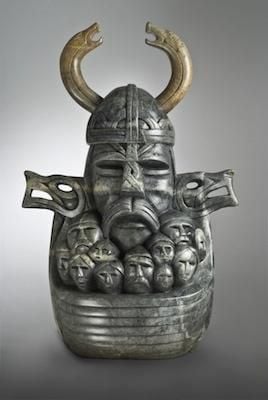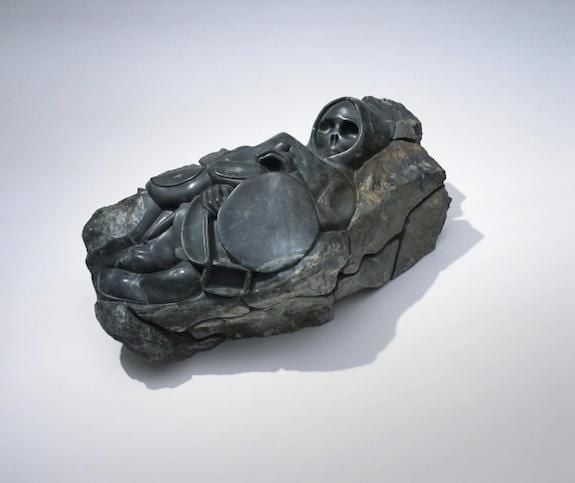Abraham Anghik Ruben’s Sculptures Now at the American Indian Museum
A new exhibition offers a contemporary look at the links between Inuit and Norse cultures
/https://tf-cmsv2-smithsonianmag-media.s3.amazonaws.com/filer/20121005081028ruben-memories-an-ancient-past_Thumbnail.jpg)
The harsh conditions of the polar north provided precisely the upbringing Native artist Abraham Anghik Ruben needed to craft his fantastical sculptures that meld Nordic and Inuit cultures. A collection of 23 of his culture-crossing works titled, “Arctic Journeys/Ancient Memories: The Sculpture of Abraham Anghik Ruben,” opens Friday October 5th at the American Indian Museum.

Though the link between the Nordic and Inuit peoples is something that has long been suggested in sagas and stories, archeological research has begun, in the past half century, to corroborate connections.
“The Vikings did not stay long in North America but the story of their arrival and contacts with Native Americans is a remarkable tale,” states a web exhibition on the Vikings, curated by the Natural History Museum’s Arctic Studies Center. The most famed of these Viking visitors is Leif Ericson, son of Greenland explorer and criminal-in-exile Erik the Red.
“This was an incredible period of exploration in the 9th century and 10th century,” says Bernadette Driscoll Engelstad, curator of Ruben’s show at the American Indian Museum. Looking for timber and fisheries, the Vikings went west from Greenland. But after christening what is today known as Newfoundland, Engelstad says, the Vikings didn’t stick around. “One reason that the Norse did not stay in North America,” explains Engelstad, “was because of the native peoples here. They were very aggressive and the sagas indicate it may well have been the native peoples of North America protecting their land and their resources that forced the Norse to discontinue any settlement and exploration.”
By the time Ruben was growing up in Paulatuk in Canada’s Northwest Territories, the Vikings were clearly long gone. His father was a hunter and his mother was a seamstress, both respected in their fields. He grew up on the land and attended a residential school in Inuvik, returning home during the summers. After going to the University of Alaska Fairbanks, Ruben settled off the coast of British Columbia, setting up his studio on the island of Salt Spring.
“As an artist I have spent the last 30 years developing my craft and having as the focus of my work the arts and cultural traditions of my Inuit background,” writes Ruben on his personal site. “My studies of circumpolar people and their movements have led me to the conclusion that their was extensive contact between my Inuit ancestors who arrived into Baffin island and Greenland at the time of the Viking-Norse settlements and expeditions.”
Ruben draws on the legends from both Inuit and Norse cultures to pick up where historical documentation ends. Drawn to the common threads of arctic cultures, including a tradition of Shamanism, Ruben generously blends iconographies with his sculptures of stone, bronze, whale bone and narwhal tusk.
“Abraham has the freedom of vision,” says Engelstad, “which I think is very interesting.” With that artistic license, says Engelstad, Ruben is able to highlight a shared maritime tradition, common mythologies about shapeshifting entities and a spiritual approach to nature across arctic cultures. To Engelstad, the connection between the two cultures at work in Ruben’s sculpture comes from a “belief in the unity, the holistic quality of nature and that boundaries are not quite as demarcated as we have made them in Western culture.”
The exhibition opens in time for the Arctic Studies Center’s 2012 conference on Inuit studies, happening October 24 through 28.

“Arctic Journeys/ Ancient Memories: The Sculpture of Abraham Anghik Ruben” runs October 5 through January, 2013 at the American Indian Museum.
/https://tf-cmsv2-smithsonianmag-media.s3.amazonaws.com/accounts/headshot/Leah-Binkovitz-240.jpg)
/https://tf-cmsv2-smithsonianmag-media.s3.amazonaws.com/accounts/headshot/Leah-Binkovitz-240.jpg)